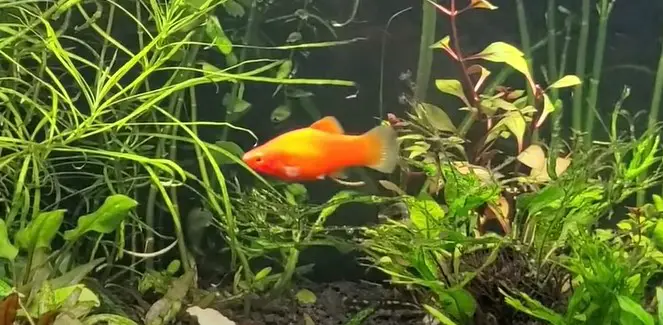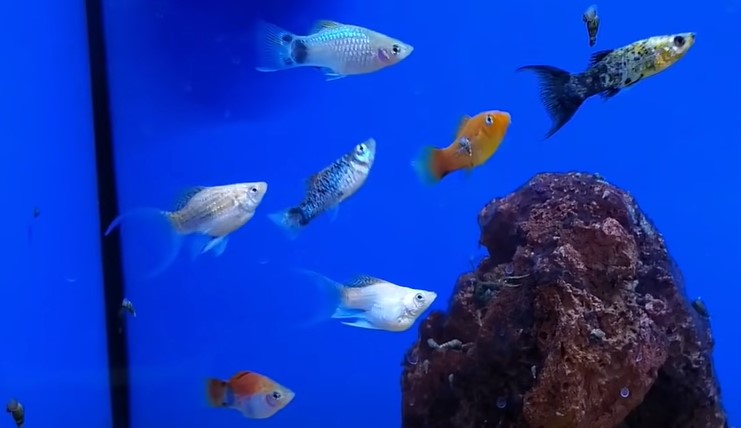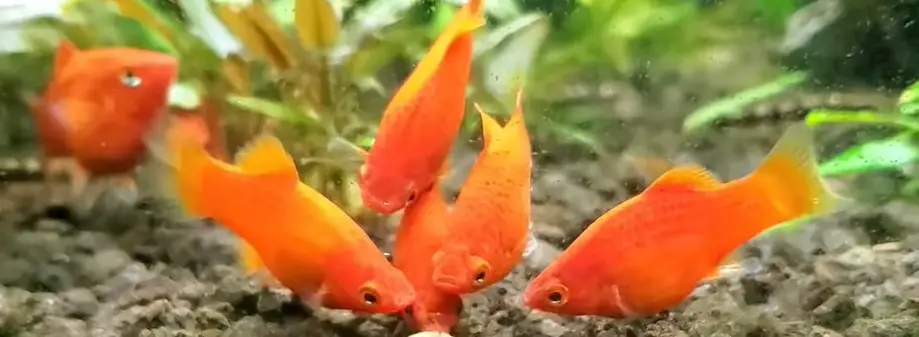I’m often asked if mollies can live in salt water. It’s an interesting question that has been debated for some time now. The answer is yes, mollies can indeed live in salt water, but with a few caveats.
In this article, I’ll explain the conditions necessary for mollies to thrive in a saltwater environment and how you can best ensure they remain healthy and happy while living in this habitat. You’ll discover why providing the right environment is so important when keeping these fish safe and what you should avoid doing when caring for them.
Finally, I’ll provide some helpful tips on how to serve your mollies while they’re living in salt water so they can continue to be an enjoyable part of your home aquarium. By understanding the basics of caring for mollies in salt water, you’ll be able to serve these wonderful creatures better and give them the best chance at a long life.
Overview Of Mollies
Have you ever wondered what type of fish a Molly is? Mollies are small, colorful, peaceful fish that makes an excellent addition to any home aquarium. There are many types of mollies, each with its own unique characteristics and behaviors. In this article, we’ll take a closer look at the different types of mollies, their behavior, and in what type of environment they thrive.
The most common type of Molly is the sailfin molly which is typically silver or black in coloration with highlights of yellow or orange on its fins. This species can grow up to four inches in length and has a lifespan between three-to-five years. Poecilia velifera is another popular species and is distinguished by its longer caudal fins, which resemble sails. These mollies also have a silvery coloration and yellow markings on their dorsal fin. They can also reach up to four inches in length and have an average lifespan of three-to-five years.
In terms of behavior, these fish tend to be quite peaceful when kept in groups with other mollies and do not display any signs of aggression towards other tankmates. However, it is important to note that if they are housed with larger or more aggressive fish, they may become stressed or even harassed by them. Therefore, it is important to keep them in an appropriately sized tank with compatible tank mates.
Regarding their environment, mollies prefer tanks with plenty of hiding spots and open swimming spaces. Water temperature should be 72-82 degrees Fahrenheit, and pH levels should remain within the 7-8 range for optimal health and well-being. As far as diet goes, these fish primarily feed on plant matter such as algae wafers but will also accept live food such as brine shrimp or bloodworms occasionally.
Now that we’ve reviewed some basics regarding mollies let’s answer our initial question: Can mollies live in salt water?

Types Of Mollies
Mollies are a diverse group of fish in many shapes, sizes, and colors. Four main types of mollies are available to most aquarium hobbyists; the dwarf molly, the balloon molly, the lyretail molly, and the sailfin molly.
The dwarf molly is one of the smallest molly species, with an average size of only two inches. They have an elongated body shape with a dark base coloration and a light-colored pattern covering their sides.
Balloon mollies are larger than dwarf mollies, growing to four inches long. They are named after their round body shape, which resembles a balloon. Their base color is usually silver or white with black markings across their body.
Lyretail mollies typically reach up to five inches in length and have an unmistakable tail shape resembling a lyre or harp. They can come in various colors, such as yellow, orange, and black. Finally, sailfin mollies are one of the largest species of mollies, reaching up to seven inches in length. As their name implies, they have large dorsal fins that can be used for protection from predators and other fishes. Their coloration varies from silvery-gray to black, depending on the variety, but all have bright blue eyes that give them an alluring look.
In summary, there are four main types of popular aquarium fish known as Mollies: Dwarf Molly, Balloon Molly, Lyretail Molly, and Sailfin Molly – each differing in size, shape, and coloration but all possessing unique characteristics that make them fascinating additions to any aquarium!

Salinity Requirements
So, can mollies live in salt water? Well, it depends on the species of molly! Many mollies are freshwater fish, while some species can survive in brackish or even saltwater environments. To understand the salinity requirements of each species, let’s dive into what you need to know to create a safe and comfortable environment for your molly.
When it comes to aquariums, salinity levels are an important factor. For mollies that inhabit freshwater environments, aquariums should have a salinity level close to 0 parts per thousand (ppt). On the other hand, mollies that prefer brackish or salty conditions will require higher salinities of up to 20-35 ppt. You’ll need a hydrometer or refractometer to monitor your aquarium’s salinity levels.
It is also important to note that maintaining stable and appropriate salinity levels is key to keeping your fish healthy and happy. When monitoring your aquarium’s salinity levels, use purified water with no impurities, as this will ensure the accuracy of readings. Additionally, be sure not to add too much salt too quickly, as this could cause serious harm to your fish!
With all this in mind, if you decide that keeping saltwater mollies is right for you and your tank setup, research what type of molly you want before adding them to the tank. Furthermore, keep a close eye on the water parameters, such as temperature and pH, and make regular partial water changes to maintain optimal conditions within the tank. Doing so will help ensure that your mollies thrive in their new home!
Setting Up An Aquarium For Mollies
Mollies are unique fish that can survive and thrive in fresh and salt water. To keep them in the best possible environment, it is important to understand how to set up the right aquarium.
The first step when setting up a tank for mollies is to decide what size tank they need. Generally, mollies do best in 10-20 gallon tanks, although larger tanks can also be used. The next step is to ensure the saltwater levels are correct; mollies prefer a salinity of 1.020 – 1.025 specific gravity (SG). Also, ensure that the pH level should be between 7.5 and 8.4, as this will keep your mollies healthy and active.
When selecting other fish to inhabit the same tank as your molly, it is important to consider their compatibility. Mollies are generally peaceful fish and can live happily with other species, such as tetras, guppies, platys, and corydoras catfish. However, it is important not to overcrowd the aquarium so that all inhabitants have enough room to swim around freely without any stress caused by competition for resources or space.
Before adding any fish to your aquarium setup, make sure that you have also provided plenty of hiding spots for them with decorations like caves or plants, which will give them an area where they can take refuge from others if needed. Providing adequate filtration systems is essential; clean water provides a healthier environment for you and your mollies! With these steps taken care of, you will have created a perfect home for your molly friends!
Care And Maintenance
Amazingly, mollies can indeed live in salt water! However, success requires careful preparation and maintenance. To ensure your mollies thrive in a saltwater tank, adhere to the following precautions:
- Monitor the water temperature and maintain it between 74-82 °F (23-28 °C).
- Clean the tank regularly with an aquarium vacuum and replace 20-25% of the water each week.
- Ensure the tank size is at least 10 gallons for one adult molly fish or 20 gallons if you’re keeping multiple mollies together.
- Feed them a diet of pellets, flakes, freeze-dried bloodworms, brine shrimp, and other appropriate food types as part of a healthy feeding schedule.
It is important to remember that all aquariums require dedication and time to keep properly maintained. If done correctly, you can be certain your mollies will have a happy home in their saltwater habitat for years to come!

Conclusion
In conclusion, mollies can be a great addition to any saltwater aquarium. While they are hardy and adaptable fish, they still require specific conditions to thrive. It is important to research the type of molly you plan on keeping and their requirements for salinity before setting up your tank. Once the tank has been established with the correct parameters, proper care, and maintenance must be taken to keep it in top condition for your new pet.
Although risks are associated with keeping a saltwater aquarium, mollies can provide an enjoyable experience for any aquarist willing to put in the effort. Not only do they add a splash of color to their environment, but they also make interesting inhabitants that will bring life to any tank. With patience and dedication, you will have no problem creating a safe and healthy home for these beautiful creatures.
I understand that this may seem like an intimidating task, but I promise it’s worth it! Keeping mollies in salt water can provide years of entertainment and satisfaction as you watch them explore their new home. All it takes is a bit of research and planning ahead; before long, you can sit back and enjoy their lively antics as they swim around your tank!
